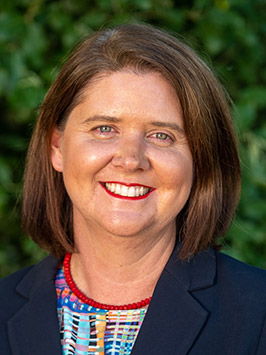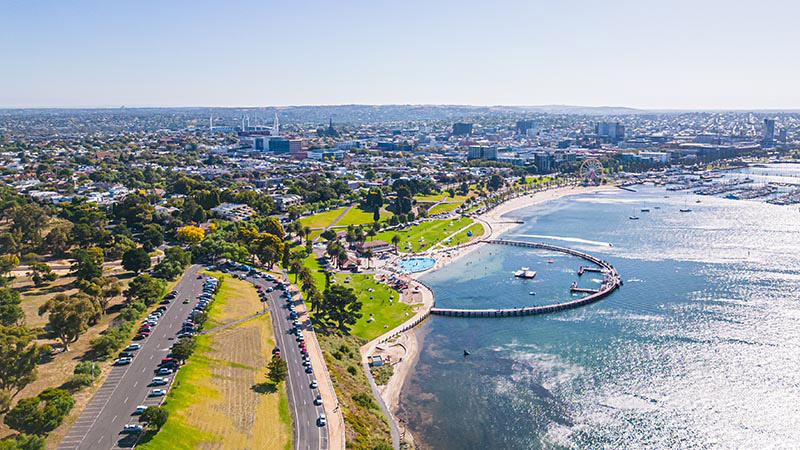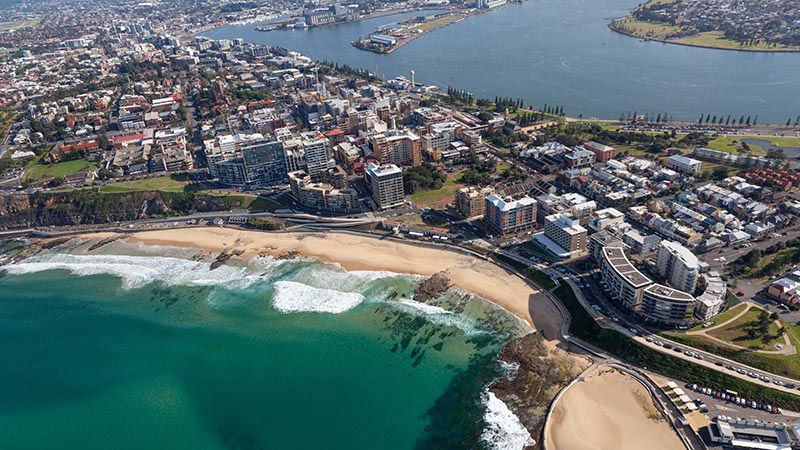The two regional cities offering clues to property investors
Two of Australia’s largest regional centres provide valuable insight into where regional markets as a whole may be heading
Regional property markets in Victoria and New South Wales have taken a hit since the exodus from the cities became a call for workers for get back to the office.
Among the top 10 best performing regional areas in those two states for price growth over the past year, only two Victorian regions even managed to attain positive growth, while in NSW four of the top 10 went backwards.
Admittedly they did better than Tasmania’s regional centres, all seven of which recorded falls of between 3 and 11 per cent but compared to the rest of Australia, the most populated states’ regional areas have struggled.
Nationally, regional dwelling values grew 1.2 per cent month on month since February according to CoreLogic’s latest Hedonic Home Value Index (HVI) data.
Combined regional median dwelling values were at $586,645 but low supply may be helping prop up prices and set the regions up for more prosperous times in regard to property prices.
The number of regional homes advertised for sale over four weeks tracked 33 per cent below the previous five-year average and sales were 8.9 per cent below average levels, key indicators for short supply keeping prices buoyed.
Rents are also attractive to investors.
Annual rental growth across the combined regional areas slowed to 4.9 per cent, following the record high of 12.5 per cent over the year to September 2021.
Higher vacancy rates are most evident across regional Australia, rising from 1.3 per cent in February 2022 to 1.5 per cent, however even at 1.5 per cent, the current rate is less than half the decade average of 3.3 per cent.
Geelong and Newcastle the canaries in the property mine
While Geelong and Newcastle dwelling values have taken a hit over the past year, the two major regional centres, are well positioned to benefit from population outflow from their metropolitan neighbours, with the offer of serviceable and affordable housing.
In Newcastle, the median home value has fallen in 12 months from $1.73 million to $1.51 million. In Geelong prices slipped 0.7 per cent in the June quarter, and for the year are down from a median of $924,000 to $881,000, according to API Magazine’s national suburb reports.
Regional Victoria is the only rest of state market where quarterly housing value trends remain negative, down 0.4 per cent in June to be 1.3 per cent lower over the quarter.
CoreLogic’s Research Director, Tim Lawless, said value declines were evident across most the sub-regions of regional Victoria, including the areas adjacent to Melbourne.
“The weaker conditions across regional parts of the state may be related to a normalisation in migration flows as more regional residents move to the city, along with a substantial narrowing of the affordability gap between regional Victoria and Melbourne through the recent upswing.”
Across the regional markets, regional NSW is recording the largest drop from peak through to the end of June, with values down 9.6%, followed by regional Victoria (-8.4 per cent) and regional Tasmania (-7.2 per cent). At the other end of the spectrum, dwelling values in regional South Australia and regional Western Australia, where housing market conditions have mostly remained positive through the rate hiking cycle to-date, recorded new cyclical highs in June.
But two of Australia’s largest regional centres provide valuable insight into where regional markets as a whole may be heading, especially for those centres not overly far from their state capitals.
Geelong population growth to drive markets
Facing future economic challenges head on, the Regional Australia Institute (RAI) played host to a Regions Rising event in Geelong on 4 July to reinforce their 10-year plan to level the playing field for services available in the regions compared with metropolitan centres and to boost regional Victoria’s population by 2032, to an extra 85,000 people.
“In the 12 months to March this year, Melbournians made up more than 50 per cent of the net outflows from capital cities to the regions, up from 44 per cent the year prior and currently 29 per cent of the 15-to-29-year age bracket live regionally, compared to 38 per cent in Melbourne and in the same data set, Greater Geelong was found to be one of the top five local government areas in regional Australia for attracting newcomers” Liz Ritchie, CEO, RAI, said at the event.

Liz Ritchie, CEO, Regional Australia Institute
Mergim Ibrahimi, Director, McGrath Estate Agents Geelong-Newtown told API Magazine said there was investor opportunity in Geelong.
“I think we’re seeing people coming down, looking at the numbers, crunching the figures and thinking they can’t afford the house they have in Melbourne, and Geelong’s a great option,” he said.
“I’ve sold a lot of properties to people from Melbourne who’ve sold their homes there for around $2 million to $2.5 million and who want to buy something in Geelong for $1.2 or $1.3 million for a better house than what they had in one of Geelong’s best suburbs and work from home two days week and commute to Melbourne - and they love it.”
“There is value here for an investor, perhaps not as much value as, say if you bought in Ballarat or if you went a bit more regional still where your yields are a bit stronger.
“Geelong still gets good capital growth, like Melbourne does, but our yield is just a fraction better than Melbourne.
“The population is growing so we’re seeing more and more of those city type of developments happening in Geelong too; it’s still early days for that but people are looking for the higher density properties you can buy for a good price, and Geelong apartments are going to be more affordable and have good returns,” Mr Ibrahimi said.

Mergim Ibrahimi, Director, McGrath Estate Agents
In the May Regional Market Update, CoreLogic recorded the highest vendor discounts on units in regional Australia were in Geelong, with a drop of 5.5 per cent compared to the same time last year when discounts were just 1.9 per cent.
Unit sales in February 2023, were down 23.3 per cent when the median unit value was $528,113 and time on the market, 46 days compared to the year previous at 21 days.
First home buyer interest from Melbourne remains strong while short supply keeps property values high but affordable.
“I currently have on the market in Highton a five-bedroom, two-bathroom, three car bay home selling for $1,095,000 to $1,195,000,” Mr Ibrahimi said.
“If you’re locked into a fixed rate and you’re at 2.7 per cent, and yours expires next year and it goes up to 6.2 or 6.3 per cent on a $1.5 million mortgage on a $3 million house or whatever it’s worth, you can sell up and move to Geelong and have a half a million-dollar mortgage or a $300,000 mortgage and probably live in an equivalent house.”
Newcastle is booming Sydney’s ‘baby brother’
While two hours from Sydney, compared to Geelong’s one to Melbourne, Newcastle also has the benefit of a major capital on its doorstep, a major shipping port and infrastructure developments underway, including a $1 billion dollar CBD East End Village build where one-bedroom residences start at $750,000 and three-bedrooms from $2.7 million, plus, a new international airport terminal estimated to attract over two million people a year.
Newcastle buyers agent, Matt Chamberlain, Managing Director, Chamberlain Brown, says there’s an exuberance coming back to the Newcastle property market.
“For example, a four-bedroom house was guided at $900,000 to $990,000 and sold on 1 July for $1,160,000 to an owner occupier after fierce bidding from multiple registered parties and it’s one of many examples of the market starting to become much more exuberant after more than a year of negative price movements,” Mr Chamberlain said.
“If we look at Newcastle as a location to invest then the adage is so true that Newcastle is the baby brother of Sydney.
“I was having a conversation with a developer who has done a lot of work in Sydney, and he used a good anecdote which is that he feels Newcastle is Sydney but 25 years ago.

Matt Chamberlain, Managing Director, Chamberlain Brown
“If you look at the data over the long term, Newcastle tends to mirror a lot of the results that Sydney achieves but probably lags by two or three or four months, so, Sydney’s gone up significantly over the last couple of months but what we’re seeing on the ground right now is going to result in higher prices in Newcastle in the next month or two.”
He said Newcastle presented investors with the opportunity to buy a property without paying Sydney prices while having all of the benefits of a strong metro centre.
“You can spend $650,000 on an older 80s style unit as a good investment fundamental, on a small block in a tightly held suburb and you could be less than two kilometres from the beach.”
Mr Chamberlain suggested lifestyle is a very close second preference for buyers after affordability in the Newcastle market.
“A buyer might be thinking, if my money can’t provide me what I’d like in Sydney I might be able to move to Newcastle and potentially if I’m a white collar worker and I commute to Sydney once or twice a fortnight but I get the benefit of being much closer to the beach in Newcastle, where there’s way less traffic and a bigger property, the overall quality of what they receive in terms of the property they can buy for their money is far, far superior.”





















